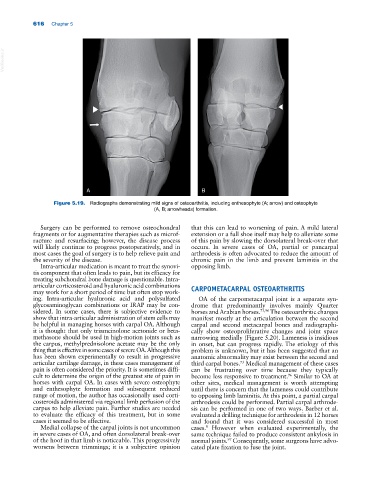Page 650 - Adams and Stashak's Lameness in Horses, 7th Edition
P. 650
616 Chapter 5
VetBooks.ir
A B
Figure 5.19. Radiographs demonstrating mild signs of osteoarthritis, including enthesophyte (A; arrow) and osteophyte
(A, B; arrowheads) formation.
Surgery can be performed to remove osteochondral that this can lead to worsening of pain. A mild lateral
fragments or for augmentative therapies such as microf- extension or a full shoe itself may help to alleviate some
racture and resurfacing; however, the disease process of this pain by slowing the dorsolateral break‐over that
will likely continue to progress postoperatively, and in occurs. In severe cases of OA, partial or pancarpal
most cases the goal of surgery is to help relieve pain and arthrodesis is often advocated to reduce the amount of
the severity of the disease. chronic pain in the limb and prevent laminitis in the
Intra‐articular medication is meant to treat the synovi- opposing limb.
tis component that often leads to pain, but its efficacy for
treating subchondral bone damage is questionable. Intra‐
articular corticosteroid and hyaluronic acid combinations CARPOMETACARPAL OSTEOARTHRITIS
may work for a short period of time but often stop work-
ing. Intra‐articular hyaluronic acid and polysulfated OA of the carpometacarpal joint is a separate syn-
glycosaminoglycan combinations or IRAP may be con- drome that predominantly involves mainly Quarter
sidered. In some cases, there is subjective evidence to horses and Arabian horses. 73,96 The osteoarthritic changes
show that intra‐articular administration of stem cells may manifest mostly at the articulation between the second
be helpful in managing horses with carpal OA. Although carpal and second metacarpal bones and radiographi-
it is thought that only triamcinolone acetonide or beta- cally show osteoproliferative changes and joint space
methasone should be used in high‐motion joints such as narrowing medially (Figure 5.20). Lameness is insidious
the carpus, methylprednisolone acetate may be the only in onset, but can progress rapidly. The etiology of this
thing that is effective in some cases of severe OA. Although this problem is unknown, but it has been suggested that an
has been shown experimentally to result in progressive anatomic abnormality may exist between the second and
articular cartilage damage, in these cases management of third carpal bones. Medical management of these cases
73
pain is often considered the priority. It is sometimes diffi- can be frustrating over time because they typically
cult to determine the origin of the greatest site of pain in become less responsive to treatment. Similar to OA at
96
horses with carpal OA. In cases with severe osteophyte other sites, medical management is worth attempting
and enthesophyte formation and subsequent reduced until there is concern that the lameness could contribute
range of motion, the author has occasionally used corti- to opposing limb laminitis. At this point, a partial carpal
costeroids administered via regional limb perfusion of the arthrodesis could be performed. Partial carpal arthrode-
carpus to help alleviate pain. Further studies are needed sis can be performed in one of two ways. Barber et al.
to evaluate the efficacy of this treatment, but in some evaluated a drilling technique for arthrodesis in 12 horses
cases it seemed to be effective. and found that it was considered successful in most
Medial collapse of the carpal joints is not uncommon cases. However when evaluated experimentally, the
8
in severe cases of OA, and often dorsolateral break‐over same technique failed to produce consistent ankylosis in
of the hoof in that limb is noticeable. This progressively normal joints. Consequently, some surgeons have advo-
97
worsens between trimmings; it is a subjective opinion cated plate fixation to fuse the joint.

